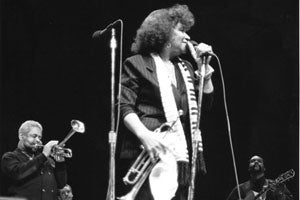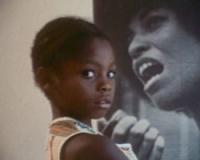The LA Rebellion series screenings on November 20th showcased filmmaker’s films on art and artists. The night opened with Elyseo Taylor’s Black Art, Black Artists and closed with Zeinabu irene Davis’s Trumpetistically, Clora Bryant. Taylor’s film served as a call to Black artists to create art that speaks to the Black experience in America and the rest of the series is a response to Taylor’s film: exhibiting a variety of Black artists depicting their experience in their work.

Taylor’s film was followed by Festival of Mask by Don Amis. This film not only exhibited Black artists, but an array of artists in a multicultural event. Its placement in the program was a positive response to Taylor’s call. The 1982 Craft and Folk Art Museum Festival of Mask showcases the dynamic ways Los Angeles residents express their native culture. Don Amis captured this event from the perspective of spectators and participants in this 25-minute documentary. His focus on masks created during community craft events, parades, culture days, and a museum related event validates an aspect of culture that is often fetishized or misunderstood. Amis shot this film when racial tension stemming from political activists being suppressed by the government was still acute. Despite waning liberation activities that fueled cultural reclamation movements, activists reclaimed and preserved affective representations of self and community including dance, costume, song and storytelling. Amis’ close shots on craftsmen creating masks, costumes worn by performers, and passion expressed in dance captured the pride and skill in cultural expression. Don Amis’ use of mask as a common language across cultures also allows the viewer to experience commonalities between the diverse cultures in Los Angeles. By situating performance as a primary method for expressing and documenting culture, Amis offers viewers a realistic portrayal of the varied ways people use mask in their own culture, interact with artistic expression in other cultures, and blend the two together. In Festival of Mask, Amis effectively removes the mask of our own prejudices from our eyes and encourages us to freely experience the wonder, joy, and enlightenment involved cultural exploration and performance.

The evening closed with Zenabu irene Davis’ Trumpetistically, Clora Bryant a look at what it is like to be a woman in an artistic field traditionally ruled by men. The film documents Clora Bryant, a female jazz trumpeter and singer who battled for recognition in the music world. Bryant is mentored by Dizzy Gillespie who states that “the trumpet is a man’s instrument” he then goes on to describe how shocked he was to see Bryant playing the instrument so well. While Gillespie worked with Bryant his commentary at the beginning of the film sets the stage for the sexism Bryant faced throughout her music career. Davis’ film follows Bryant from her childhood to her early years as a trumpeter with the Prairie View Co-Eds, an all girl swing band, all the way up to her receiving of the Mary Lou Williams Women in Jazz Award in 2002. While Bryant was a well known performer on the Central Avenue scene (the Los Angeles jazz hub from the 1920s – the mid 1950s), she was unable to make a living at it. Even now after receiving the lifetime achievement award, Bryant is not financially stable. Davis’ film showcases Bryant’s talent without glossing over the way her gender inhibited her progress. Many of those interviewed described how male trumpeters that were less talented than Bryant would be picked up by music promoters, while Bryant never received an offer.
As the closing film, Davis’ piece served as both a celebration of an incredible Black female artist, and a call for equality. Davis’ call for justice mirrors Taylor’s call to action.
—Moana Sherrill and Dalena Hunter






 Mobile Navigation
Mobile Navigation

